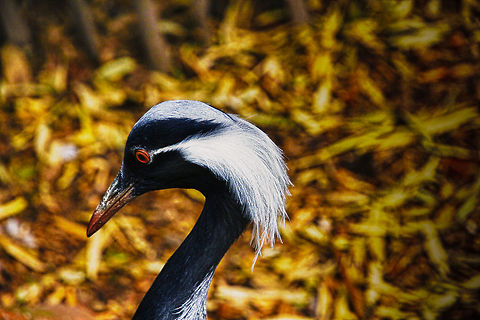
Appearance
The Demoiselle is 85–100 cm long with a 155–180 cm wingspan. It weighs 2–3 kg. It is the smallest species of crane. The Demoiselle Crane is slightly smaller than the Common Crane but has similar plumage. It has a long white neck stripe and the black on the foreneck extends down over the chest in a plume.It has a loud trumpeting call, higher-pitched than the Common Crane. Like other cranes it has a dancing display, more balletic than the Common Crane, with less leaping.

Cultural
The Demoiselle Crane is known as the "Koonj" in the languages of North India and Pakistan, and figure prominently in the literature, poetry and idiom of the region. Beautiful women are often compared to the "koonj" because its long and thin shape is considered graceful. Metaphorical references are also often made to the "koonj" for people who have ventured far from home or undertaken hazardous journeys.The name "koonj" is derived from the Sanskrit word "kraunch", which is a cognate Indo-European term for "crane" itself. In the traditional telling of the history of Valmiki, the composer of the Hindu epic Ramayana, he composed his first verse when he saw a hunter kill the male of a pair of Demoiselle Cranes that were making love. Observing the lovelorn female circling and crying in grief, he cursed the hunter in verse. Since tradition held that all poetry prior to this moment had been revealed rather than created by man, this verse concerning the Demoiselle Cranes is regarded as the first human-composed meter.
The flying formation of the "koonj" during migrations also inspired infantry formations in ancient India. The Mahabharata epic describes both warring sides adopting the "koonj" formation on the second day of the Kurukshetra War.
References:
Some text fragments are auto parsed from Wikipedia.